
Shimla – In a resolute move towards safeguarding the state against natural calamities, the HP State Executive Committee convened under the leadership of Chief Secretary Prabodh Saxena. The 20th meeting of the committee underscored the need for a scientific and sustainable strategy to pre-empt and mitigate disasters, marking a significant step forward in bolstering Himachal Pradesh’s resilience.
At the core of the discussions was a comprehensive analysis of the various vulnerabilities present across different regions of the state. The meeting aimed to identify specific measures that can be implemented to either prevent or mitigate potential disasters. The focus extended to refining coordinated response mechanisms in the face of life-threatening situations.
Chief Secretary Prabodh Saxena highlighted the dire need for a permanent scientific approach to disaster prevention. He stressed the importance of developing innovative solutions that address the vulnerabilities associated with floods, landslides, earthquakes, and other potential disasters.
During the meeting, Chief Secretary Saxena shared that a memorandum detailing losses amounting to Rs. 6746.93 crore had been submitted to the Union Ministry of Home Affairs. This plea for assistance is intended to facilitate recovery efforts, with the Disaster Management Cell also calling upon the National Disaster Management Authority to conduct a Post Disaster Needs Assessment.
To enhance preparedness, Chief Secretary Saxena emphasized the importance of training the state’s first responders, particularly the police forces. In times of crisis, they play a pivotal role in ensuring swift and effective action. Saxena’s directive aligns with the overarching goal of providing rapid and efficient response mechanisms during emergencies.
Furthermore, the committee explored strategies for earthquake retrofitting of critical infrastructure. The proposal involves piloting this initiative in select districts, focusing on essential assets such as government schools and community health centers. The discussions also encompassed the strengthening of agencies responsible for disaster management, including the Disaster Management Cell, District Disaster Management Authorities, Fire Services, Home Guards, and Civil Defense.
Addressing urban safety, the committee called for the adoption and stringent enforcement of Model Building Bye Laws by all Urban Local Bodies. They also emphasized the necessity of ensuring safe construction practices in rural areas. Additionally, regulations were deliberated upon to manage construction near rivers, streams, and steep slopes.








